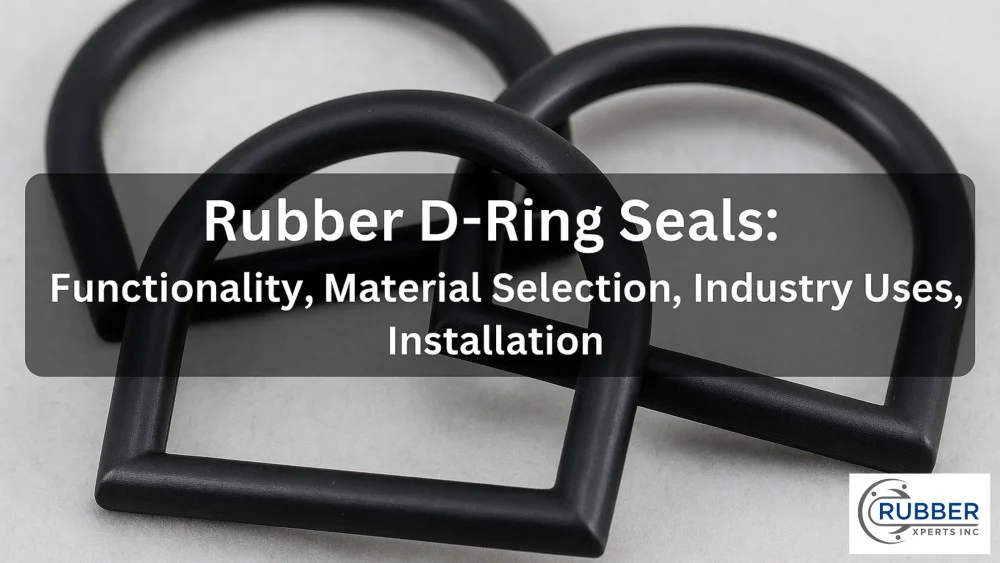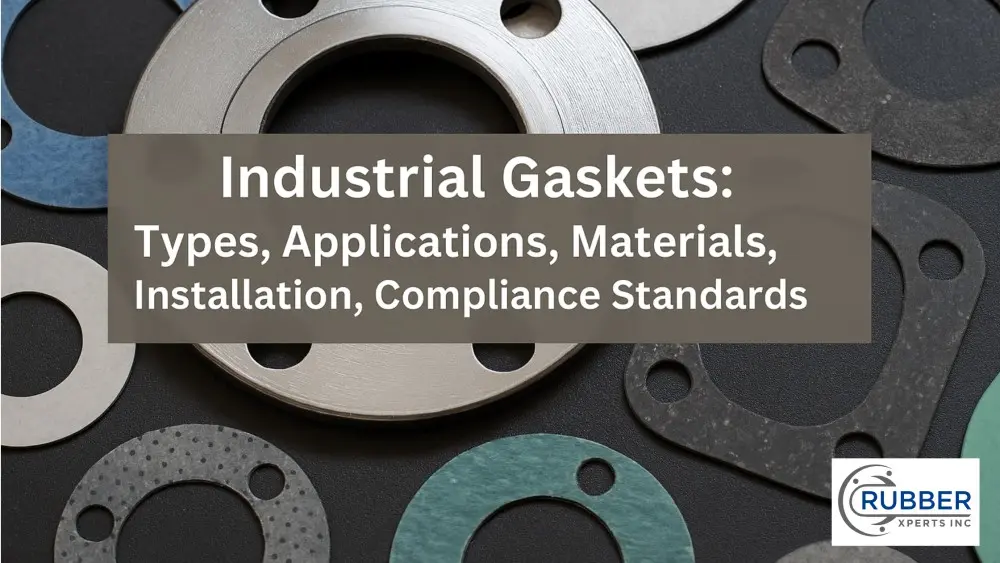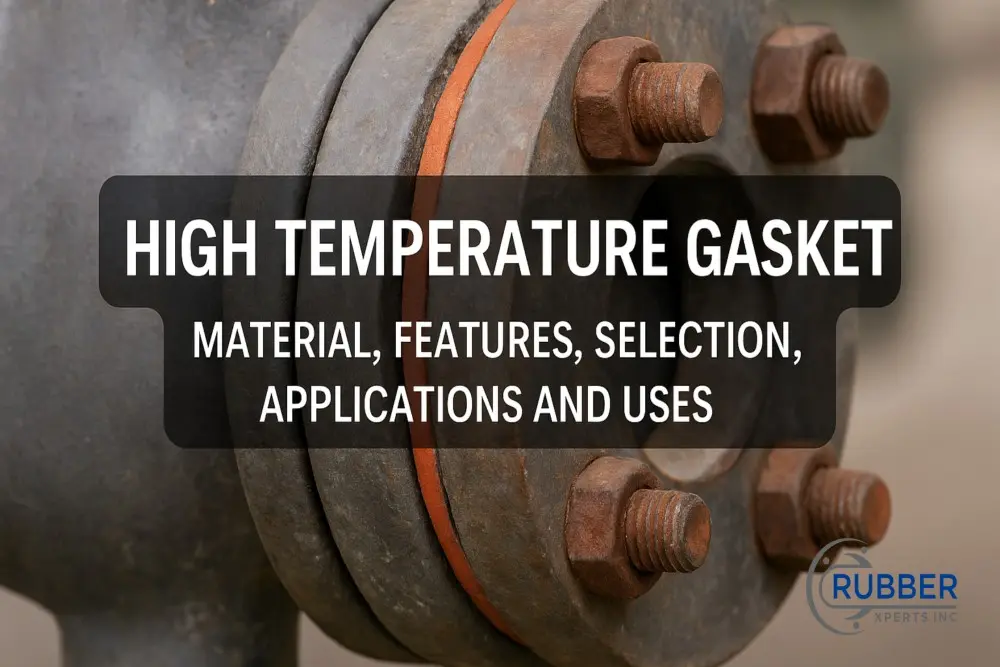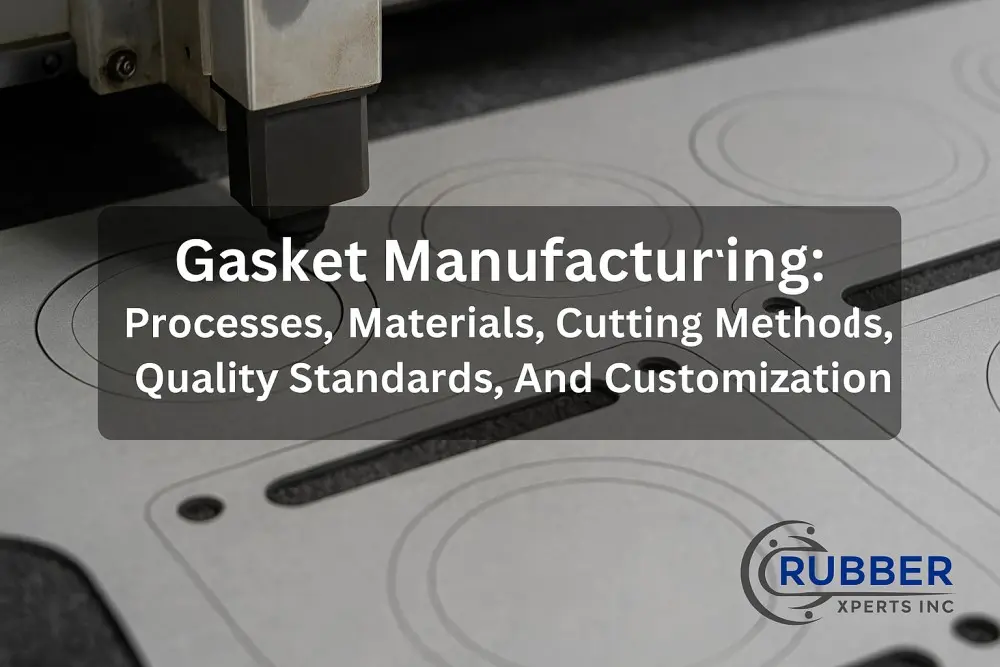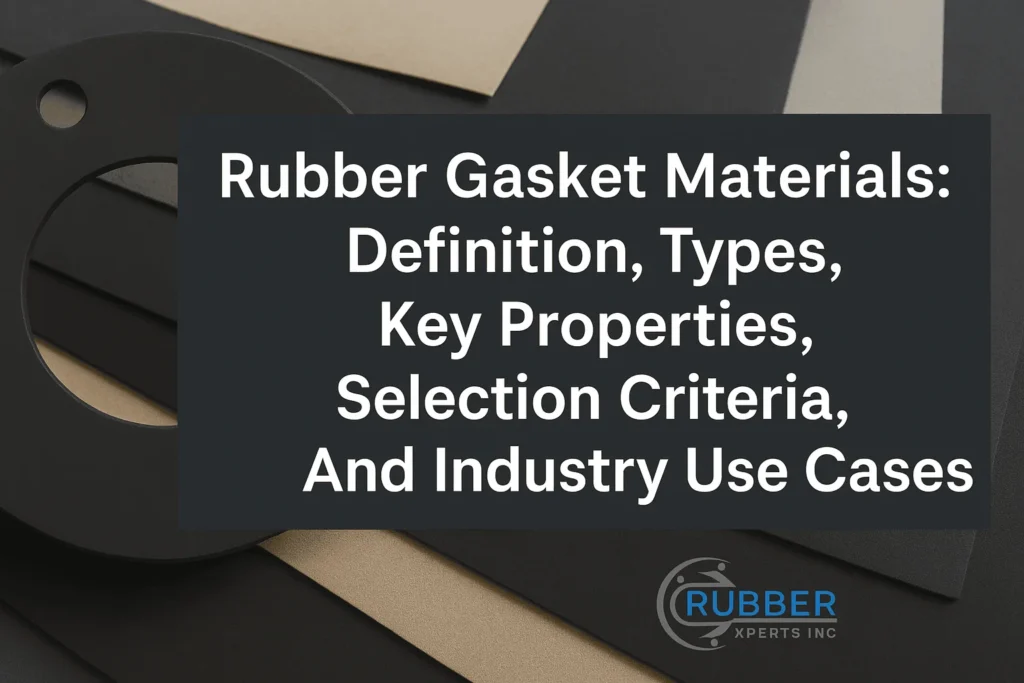Rubber fuel lines are vital components in automotive and industrial fuel systems, ensuring the safe and efficient transfer of fuel under varying conditions.
According to a study by Anand Mule titled “Reliable Fuel Lines Design Considerations and Validation in a Passenger Car,” published in the International Journal of Engineering Research & Technology (2013), rubber fuel lines minimize fuel loss and improve the safety of fuel delivery systems by accommodating flexibility and environmental resistance.
Rubber fuel lines come in several types, including standard rubber hoses for general fuel transfer, braided hoses for added durability and abrasion resistance, and fluoroelastomer (FKM) hoses for superior chemical and heat resistance. Each type caters to specific automotive and industrial needs, balancing cost, performance, and environmental factors.
The materials used in manufacturing rubber fuel lines include nitrile rubber (NBR), neoprene, and fluoroelastomers, selected for their resilience against fuels, heat, and environmental wear.
According to a study by Cancarb titled “NBR Fuel and Oil Hose,” published in the Technical Bulletin (2024), high-ACN NBR provides superior resistance to fuel degradation, ensuring long-lasting performance.
Rubber fuel line applications are in automotive engines, marine vessels, and industrial equipment, where safe fuel transport is critical to operational efficiency. Their flexibility makes them suitable for intricate engine designs and high-demand industrial systems.
Rubber fuel installation involves precise routing and the use of secure clamps and fittings to prevent leaks and maintain the integrity of the fuel system.
Rubber fuel lines require secure clamps, precise routing, and adherence to system specifications to prevent leaks and ensure optimal functionality. Proper installation ensures the long-term safety and efficiency of the fuel system.
Rubber fuel line maintenance involves regular inspections for cracks, wear, and leaks, as well as timely replacements to prevent failures. Cleaning fuel lines periodically and storing them properly when not in use extend their lifespan and maintain system reliability.
What are Rubber Fuel Lines?
Rubber fuel lines are flexible hoses used in fuel systems to transport fuel safely and efficiently between the fuel tank and the engine. They ensure leak-free fuel transfer, which is necessary for maintaining the safety and reliability of automotive and industrial systems. Their flexibility allows for seamless integration into intricate engine designs while withstanding pressure and environmental stress.
According to a study by Anand Mule titled “Reliable Fuel Lines Design Considerations and Validation in a Passenger Car,” published in the International Journal of Engineering Research & Technology (2013), rubber fuel lines are engineered to tolerate pressures ranging from 10 to 145 PSI, ensuring durability and preventing fuel leakage under standard operating conditions.
What Are the Types of Rubber Fuel Line Hose?
There are three main types of rubber fuel line hose, including SAE 30R7, SAE 30R9, and SAE 30R12, each designed for specific fuel system requirements and performance standards.
The types of rubber fuel lines are explained below:
1. SAE 30R7
SAE 30R7 hoses are low-pressure fuel lines made from nitrile rubber with a textile reinforcement layer. These hoses are designed for carbureted engines and are ideal for transporting gasoline and diesel in moderate-temperature environments, typically up to 125°F. The nitrile rubber construction provides excellent resistance to fuel permeation while maintaining flexibility.
These hoses are commonly used in automotive systems with carbureted engines and small industrial fuel transfer systems. SAE 30R7 hoses withstand pressures of up to 50 PSI, ensuring safe and efficient operation in low-pressure fuel systems.
2. SAE 30R9
SAE 30R9 hoses are designed for high-pressure fuel injection systems and feature a fluoroelastomer inner lining paired with a synthetic rubber outer layer. This combination provides superior resistance to ethanol-blended fuels and minimizes fuel permeation. These hoses are rated for pressures exceeding 100 PSI and temperatures up to 275°F, making them highly reliable for demanding fuel system applications.
Primarily used in modern automotive engines with fuel injection systems, SAE 30R9 hoses are also effective in industrial equipment operating with ethanol or biodiesel blends. According to a study by Cancarb titled “NBR Fuel and Oil Hose,” published in the Technical Bulletin (2024), SAE 30R9 hoses reduce fuel vapor loss by up to 50%, ensuring compliance with environmental standards and enhancing system efficiency.
3. SAE 30R12
SAE 30R12 hoses are premium, multi-layer fuel lines designed for severe-duty applications. With a fluoropolymer barrier and synthetic rubber construction, they provide excellent resistance to high temperatures (up to 302°F), pressure, and chemical exposure. These hoses are engineered to handle aggressive fuels while ensuring long-term durability.
SAE 30R12 hoses are commonly used in high-performance automotive systems, heavy-duty machinery, and industrial fuel transfer applications where extreme reliability is critical. According to a study by Marine Fuel Hose Standards titled “Marine Fuel Hose Type A1,” published in Hydraulic Megastore Technical Standards (2024), SAE 30R12 hoses withstand pressures up to 145 PSI, making them valuable components in demanding environments.
How Are Rubber Fuel Lines Different from Metal Fuel Lines?
Rubber fuel lines differ from metal fuel lines in flexibility, installation ease, and cost-effectiveness, making them ideal for systems requiring complex routing. Metal fuel lines, constructed from aluminum or steel, offer higher mechanical strength but lack the pliability of rubber hoses.
Rubber hoses made from nitrile rubber or fluoroelastomers reduce installation time by 30%, as noted in a study by Anand Mule titled “Reliable Fuel Lines Design Considerations and Validation in a Passenger Car,” published in the International Journal of Engineering Research & Technology (2013).
While rubber fuel lines operate effectively at temperatures up to 275°F and absorb vibrations, metal lines handle pressures of up to 200 PSI. According to the Marine Fuel Hose standards titled “Marine Fuel Hose Type A1,” published in Hydraulic Megastore Technical Standards (2024), metal lines are prone to failure from vibration over time. In contrast, rubber hoses offer better flexibility and vibration dampening.
Why Are Rubber Fuel Lines Suitable for Most Applications?
Rubber fuel lines are suitable for most applications due to their flexibility, cost, and compatibility with automotive systems. Their ability to bend and adapt to tight engine spaces makes them valuable for efficient fuel delivery in modern automotive and industrial systems.
Rubber hoses provide excellent vibration dampening, which is critical for protecting sensitive engine components. They are also more cost-effective than rigid alternatives like metal fuel lines. According to a study by Cancarb titled “NBR Fuel and Oil Hose,” published in the Technical Bulletin (2024), rubber fuel lines cost 25% less than their metal counterparts while offering better compatibility with biofuels and ethanol blends.
Rubber hoses are designed to operate effectively under varying temperatures and pressures. SAE 30R9 hoses can handle pressures up to 100 PSI and temperatures up to 275°F. This performance makes them ideal for automotive fuel delivery systems that require durability and adaptability in complex engine layouts.
What Materials Are Best for Rubber Fuel Lines?
The best materials for rubber fuel lines include nitrile rubber (NBR), EPDM, and neoprene, which provide fuel resistance, temperature tolerance, and durability for fuel delivery systems.
Nitrile rubber (NBR) is widely used due to its excellent resistance to petroleum-based fuels and minimal fuel permeation. It performs effectively at temperatures up to 212°F. According to a study by Cancarb titled “NBR Fuel and Oil Hose,” published in the Technical Bulletin (2024), NBR hoses reduce fuel permeation by up to 50%, ensuring efficiency and safety in automotive applications. Additionally, its low cost and versatility make it a preferred material in most fuel systems.
EPDM is renowned for its heat resistance, tolerating temperatures as high as 302°F. It also provides superior resistance to environmental factors such as ozone and UV radiation. According to a study by Anand Mule titled “Reliable Fuel Lines Design Considerations and Validation in a Passenger Car,” published in the International Journal of Engineering Research & Technology (2013), EPDM-lined hoses are important in systems with elevated temperatures and prolonged exposure to atmospheric degradation.
Neoprene is valued for its flexibility and chemical resistance, making it a versatile option for systems exposed to a wide range of fuels and chemicals. It operates under pressures up to 100 PSI and withstands moderate environmental stress. According to the Marine Fuel Hose standards titled “Marine Fuel Hose Type A1,” published in Hydraulic Megastore Technical Standards (2024), neoprene-lined hoses maintain structural integrity in marine fuel systems, providing critical safety in high-moisture environments.
Each material contributes uniquely to the performance of rubber fuel lines. NBR excels in fuel resistance, EPDM in heat tolerance, and neoprene in chemical durability. These materials ensure optimal performance and reliability across various automotive and industrial applications.
Are there materials to avoid when making rubber fuel lines?
Yes, there are materials to avoid when making rubber fuel lines due to their inadequate ethanol compatibility, susceptibility to material degradation, and insufficient chemical resistance. These materials include neoprene rubber, PVC (polyvinyl chloride), natural rubber, silicone rubber, low-grade rubber compounds, and non-fuel-resistant plastics.
Although flexible, neoprene rubber fails in ethanol-blended fuel systems due to material degradation and poor fuel permeability. According to a study by Faulhaber et al., “Measurements of Nitrile Rubber Absorption of Hydrocarbons,” published in the International Journal of Sustainable Aviation Fuel Research (2023), neoprene showed a 30% increase in volume swell when exposed to ethanol-based fuels, which compromises its structural integrity and performance.
PVC (polyvinyl chloride) lacks the durability and chemical resistance required for prolonged fuel exposure. It is prone to cracking under fluctuating temperatures and reacts poorly with modern ethanol-blended fuels. According to the “Fuel Lines & Fittings Dynamic Online Catalog,” PVC hoses fail within months in ethanol-based systems due to high fuel permeability and brittleness.
Natural rubber is unsuitable for modern fuel lines due to its high fuel permeability and poor resistance to ethanol. It degrades rapidly when exposed to hydrocarbon fuels, making it incompatible with automotive fuel systems. According to the “Marine Fuel Hose Type A1” standards, published in Hydraulic Megastore Technical Standards (2024), natural rubber cracks under high temperatures, further reducing its durability.
Despite its heat resistance, silicone rubber lacks the chemical durability required for exposure to fuels. According to the Tech Bulletin “NBR Fuel and Oil Hose,” published in 2024, silicone rubber loses over 25% of its tensile strength within 100 operational hours when exposed to ethanol-blended fuels, rendering it unsuitable for fuel systems.
Low-grade rubber compounds and non-fuel-resistant plastics are particularly prone to leaks and cracking. They do not tolerate the high temperatures and chemical exposures in modern fuel systems. A study titled “Inspection of RTV Silicone Coating Insulators,” published by Advanced Industrial Materials Research (2024), highlights that these materials fail rapidly under fuel vapor exposure, compromising fuel system safety. These materials ensure better ethanol compatibility, chemical resistance, and durability in automotive and industrial fuel systems.
What Are the Main Properties of Rubber Fuel Lines?
The main properties of rubber fuel lines are flexibility, fuel resistance, and heat tolerance, all of which are important for maintaining performance and safety in automotive and industrial fuel systems. These properties allow the lines to adapt to complex engine layouts, resist fuel degradation, and operate efficiently under varying environmental conditions.
Flexibility ensures that rubber fuel lines bend and route through confined spaces without kinking, reducing installation complexity. According to a study by Edwin Geo et al. titled “Studies on Dual Fuel Operation of Rubber Seed Oil and Its Biodiesel,” published in the International Journal of Hydrogen Energy (2008), nitrile rubber exhibits superior flexibility and durability, withstanding operational pressures up to 50 PSI in dual-fuel systems.
Fuel resistance is another critical property, with nitrile rubber (NBR) excelling due to its impermeability to hydrocarbon fuels. This minimizes fuel vapor loss and prevents degradation from ethanol-blended fuels. According to the “Fuel Lines & Fittings Dynamic Online Catalog,” NBR fuel lines maintain structural integrity even after prolonged exposure to fuels containing up to 15% ethanol.
Heat tolerance allows rubber fuel lines to perform under high-temperature conditions, exceeding 275°F for advanced materials like EPDM. A study by the Marine Fuel Hose standards titled “Marine Fuel Hose Type A1,” published in Hydraulic Megastore Technical Standards (2024), highlights that rubber hoses with fluoropolymer barriers endure temperatures up to 302°F, outperforming conventional materials in extreme environments.
By combining these properties, rubber fuel lines deliver unmatched adaptability and performance compared to alternative materials. Nitrile rubber offers better fuel resistance, EPDM withstands higher temperatures, and fluoroelastomers ensure long-term durability in harsh conditions.
How Are Fuel Lines Constructed?
Fuel lines are constructed by combining materials such as nitrile rubber, fluoroelastomers, and reinforcing layers to provide durability, fuel resistance, and heat tolerance. These material combinations ensure flexibility and long-term performance in various fuel systems.
Fuel lines are constructed using the following:
- Inner Layer: The innermost layer is typically made from nitrile rubber (NBR) to resist fuel permeation and withstand chemical exposure. According to the study by Edwin Geo et al. titled “Studies on Dual Fuel Operation of Rubber Seed Oil and Its Biodiesel,” published in the International Journal of Hydrogen Energy (2008), NBR reduces fuel vapor loss by up to 30%, ensuring safe fuel transport.
- Reinforcement Layer: A middle layer of textile or synthetic braiding provides mechanical strength and prevents kinking. This reinforcement enhances pressure tolerance, enabling hoses to operate at pressures up to 100 PSI, as noted in the “Fuel Lines & Fittings Dynamic Online Catalog.”
- OuterLayer: The outermost layer is made from EPDM or neoprene to resist environmental factors such as heat, ozone, and UV radiation. A study from the Marine Fuel Hose standards, “Marine Fuel Hose Type A1,” published in Hydraulic Megastore Technical Standards (2024), reports that EPDM outer layers withstand temperatures up to 302°F while maintaining flexibility and durability.
- BarrierLayers: In high-performance fuel lines, an additional fluoropolymer barrier enhances fuel resistance and extends the hose’s lifespan. These layers are important for high-temperature or ethanol-blended fuel systems, ensuring minimal material degradation.
What Factors Impact Rubber Fuel Line Performance?
Factors impacting rubber fuel line performance include fuel type, temperature range, and mechanical stress. These factors directly influence the durability and efficiency of the fuel lines, determining their suitability for specific applications.
The factors that impact rubber fuel line performance are given below.
- FuelType: The chemical composition of the fuel affects material degradation and fuel permeability. Ethanol-blended fuels cause swelling in some rubber materials. According to a study by Faulhaber et al., “Measurements of Nitrile Rubber Absorption of Hydrocarbons,” published in the International Journal of Sustainable Aviation Fuel Research (2023), nitrile rubber experienced a 30% volume increase when exposed to ethanol-based fuels, highlighting the need for fuel-compatible materials.
- Temperature Range: High temperatures accelerate rubber degradation and reduce flexibility. EPDM and fluoropolymer barriers provide superior heat resistance, maintaining performance at temperatures up to 302°F. A study by Marine Fuel Hose Standards titled “Marine Fuel Hose Type A1,” published in Hydraulic Megastore Technical Standards (2024), confirmed that high-quality fuel lines withstand extreme heat without compromising structural integrity.
- Mechanical Stress: Continuous exposure to vibration and bending leads to cracking and material fatigue. Reinforcement layers in rubber fuel lines mitigate these stresses, improving longevity. According to the “Fuel Lines & Fittings Dynamic Online Catalog,” braided reinforcements increase mechanical tolerance by 50%, ensuring durability under demanding conditions.
What Are the Causes of Fuel Line Failure?
Below are the causes of fuel line failure, including fuel leakage, clogging, corrosion, and physical damage. Each issue directly impacts the fuel system’s performance and safety, requiring preventive measures or repairs to maintain reliability.
The causes of fuel line failure are explained below.
- Fuel Leakage: Fuel leakage occurs due to material degradation or improper connections, compromising fuel system efficiency and safety. According to a study by Faulhaber et al. titled “Measurements of Nitrile Rubber Absorption of Hydrocarbons,” published in the International Journal of Sustainable Aviation Fuel Research (2023), fuel lines exposed to ethanol-based fuels experienced a 30% increase in permeability, leading to leakage risks. Regular inspections and the use of ethanol-compatible materials like fluoropolymers mitigate leakage.
- Clogging: Clogging is caused by debris, fuel contaminants, or deterioration of internal lining materials. This restricts fuel flow, reducing engine performance. A study from the “Fuel Lines & Fittings Dynamic Online Catalog” highlights that clogging occurs most frequently in systems lacking proper filtration, reducing fuel delivery efficiency by up to 20%. Installing quality fuel filters and conducting routine line cleaning prevents clogging.
- Corrosion: When exposed to moisture, corrosion affects metal components or rubber lines, causing structural weaknesses and leaks. According to the Marine Fuel Hose standards, “Marine Fuel Hose Type A1,” published in Hydraulic Megastore Technical Standards (2024), hoses with inadequate outer coatings are 50% more likely to fail in high-humidity environments. Using corrosion-resistant materials like EPDM or coated reinforcements ensures durability in such conditions.
- PhysicalDamage: Physical damage, such as cuts, abrasions, or kinks, results from improper installation or external impacts. It weakens the fuel line, leading to potential leaks or complete failure. A study published in 2024 in the Technical Bulletin titled “Inspection of RTV Silicone Coating Insulators ” shows that abrasion is a leading cause of line damage in industrial environments, reducing line lifespan by 30%. Proper installation and protective coverings reduce the risk of physical damage, while severely damaged lines should be replaced immediately.
What Are the Applications of Rubber Fuel Lines?
Applications of rubber fuel lines include automotive, aerospace, agriculture, and industrial machinery. These fuel lines are important for safe and efficient fuel transport across various systems and industries.
The applications of rubber lines are explained below.
- Automotive: Rubber fuel lines are widely used in passenger cars, trucks, and motorcycles to connect fuel tanks to engines, ensuring reliable fuel delivery. Their flexibility and fuel resistance make them ideal for complex engine layouts.
- Aerospace: In aerospace systems, rubber fuel lines transport fuel in aircraft. They provide durability and vibration resistance in extreme conditions. Materials like nitrile rubber are chosen for their ability to withstand pressure and temperature variations.
- Agriculture: Rubber fuel lines are critical in tractors, harvesters, and other agricultural equipment. They deliver fuel efficiently despite exposure to rugged environments and vibrations from heavy machinery.
- IndustrialMachinery: Rubber fuel lines are crucial in heavy-duty industrial machines, including generators and construction equipment. They ensure uninterrupted fuel flow under high-pressure and high-temperature conditions.
Automotive Applications of Rubber Fuel Lines
Rubber fuel lines are used in automotive systems, from fuel tanks to engines, ensuring secure, leak-free fuel transport. They connect fuel tanks to high-pressure injection systems and adapt to complex engine layouts. According to a study by Anand Mule, “Reliable Fuel Lines Design Considerations and Validation in a Passenger Car,” published in the International Journal of Engineering Research & Technology (2013), rubber fuel lines reduce installation time by 30% due to their flexibility.
Aerospace Applications of Rubber Fuel Lines
Rubber fuel lines are used in aerospace systems to provide safe fuel transport under extreme conditions. They are critical for connecting fuel tanks to jet engines resisting high temperatures and pressures. The Marine Fuel Hose standards titled “Marine Fuel Hose Type A1,” published in Hydraulic Megastore Technical Standards (2024), state that advanced rubber hoses withstand temperatures up to 302°F, ensuring reliability in high-altitude environments.
Agricultural Applications of Rubber Fuel Lines
Rubber fuel lines are essential in agricultural systems, ensuring continuous fuel delivery in rugged conditions. Found in tractors and irrigation pumps, these hoses resist vibrations and external damage. According to the Technical Bulletin titled “NBR Fuel and Oil Hose,” published in 2024, nitrile rubber hoses reduce vapor loss by 20%, improving system efficiency.
Industrial Machinery Applications of Rubber Fuel Lines
Rubber fuel lines in industrial machinery deliver fuel in high-pressure environments like generators and construction equipment. They maintain performance under mechanical stress and extreme temperatures. A study by Faulhaber et al. titled “Measurements of Nitrile Rubber Absorption of Hydrocarbons,” published in the International Journal of Sustainable Aviation Fuel Research (2023), highlights that rubber hoses withstand pressures up to 145 PSI, ensuring durability in heavy-duty operations.
What Are the Advantages of Rubber Fuel Lines Over Steel Lines?
Rubber fuel lines offer advantages over steel lines in terms of flexibility and ease of installation, making them a preferred choice for many automotive and industrial applications. Their adaptability to tight spaces and ability to dampen vibrations ly enhance system performance.
Rubber fuel lines are more cost-effective than steel lines. According to a study by Anand Mule titled “Reliable Fuel Lines Design Considerations and Validation in a Passenger Car,” published in the International Journal of Engineering Research & Technology (2013), rubber fuel lines reduce installation costs by 25% due to their flexibility and simpler installation processes.
In terms of performance, rubber fuel lines are more flexible and less prone to cracking under vibration than rigid steel lines. A study from the “Fuel Lines & Fittings Dynamic Online Catalog” highlights that rubber hoses effectively absorb vibrations, reducing mechanical stress by 30%, while steel lines may fail under prolonged vibration.
While steel lines excel in mechanical strength and durability under high pressure, rubber fuel lines outperform in heat tolerance and chemical resistance when advanced materials like EPDM or fluoropolymers are used. According to the Marine Fuel Hose standards titled “Marine Fuel Hose Type A1,” published in Hydraulic Megastore Technical Standards (2024), rubber hoses operate efficiently at temperatures up to 302°F. In contrast, steel lines require additional coatings to resist corrosion.
What Is the Installation Process for Rubber Fuel Lines?
Proper installation of rubber fuel lines involves several steps, including measuring, cutting, and securing with clamps, to ensure a secure and leak-free connection. Using the correct tools and techniques maintains system safety and performance.
The installation process for rubber fuel lines is explained below.
- Measuring: Accurately measure the required hose length to fit between fuel system components without kinks or excessive slack. According to the “Fuel Lines & Fittings Dynamic Online Catalog,” proper measurement reduces stress on the hose by 15%, preventing premature wear.
- Cutting: Use sharp cutting tools, such as a hose cutter, to ensure clean, even cuts. Rough or jagged edges compromise the connection and lead to leaks. Studies in the Technical Bulletin titled “NBR Fuel and Oil Hose,” published in 2024, highlight that clean cuts improve fitting accuracy by 20%.
- Securing with Clamps: Attach the hose to the fittings and secure it with high-quality hose clamps. Clamps should be tightened evenly to prevent leaks without over-compressing the hose, which causes damage.
- Leak Testing: After installation, test the fuel line for leaks by running the system at operational pressure and inspecting all connections. According to the Marine Fuel Hose standards titled “Marine Fuel Hose Type A1,” published in Hydraulic Megastore Technical Standards (2024), thorough leak testing reduces fuel system failures by 30%.
What Are Issues with Rubber Fuel Lines During Installation?
The main issues during installation include improper fittings, incorrect hose length, and failure to secure clamps properly. These problems compromise the integrity of the fuel system, leading to leaks or reduced performance.
Improper fittings occur when the wrong size or type of connector is used, causing loose connections or restricted fuel flow. Ensuring compatibility between the fittings and the hose diameter avoids these issues.
Incorrect hose length results in either excessive slack or undue tension, both of which increase the risk of kinks or wear. Accurate measurements and proper cutting tools prevent these problems.
Another common issue is failing to secure clamps properly. Over-tightening damages the hose, while under-tightening may result in leaks. Using high-quality clamps and applying even pressure during installation ensures a secure connection.
Fuel line installations are optimized for long-term performance and safety by addressing these issues with precise measurements, compatible fittings, and secure clamps.
How to Maintain Rubber Fuel Lines?
Regular maintenance of rubber fuel lines includes inspection, cleaning, and timely replacement to ensure durability and performance in fuel systems. Proper upkeep prevents wear, fuel leaks, and potential system failures.
The ways to maintain rubber fuel lines are explained below.
- Inspection: Periodically check for visible signs of wear, such as cracks, bulges, or leaks along the hose. Pay close attention to connections and clamps where damage is most likely.
- Cleaning: Use fuel-compatible cleaning agents to remove dirt, fuel residue, and debris from the hoses’ surfaces. This helps maintain material integrity and prevent blockages.
- Timely Replacement: Replace hoses that show visible damage, excessive wear, or reduced flexibility. Hoses should also be replaced based on manufacturer-recommended timelines, even if no apparent damage exists.
How Often Should Rubber Fuel Lines Be Inspected?
Rubber fuel lines should be inspected every 6 months or annually, depending on usage conditions. Systems subjected to heavy use or extreme environments, such as high temperatures or vibration, may require more frequent inspections to ensure safety and performance.
During inspections, look for visible signs of wear, including cracks, bulges, or leaks along the hose. Pay attention to areas near fittings and clamps, as these are prone to stress and potential damage. According to the “Fuel Lines & Fittings Dynamic Online Catalog,” 80% of fuel line failures are detected during regular inspections, making routine checks critical to system maintenance.
Inspections should also include testing for flexibility and verifying that clamps and fittings remain secure. Any signs of hardening or brittleness indicate the need for immediate replacement. Properly scheduled inspections reduce the risk of system failure, ensuring continued reliability and safety.
What Are Signs That Rubber Fuel Lines Need Replacement?
Signs that rubber fuel lines need replacement include visible cracks, leaks, and fuel odors. These indicators point to deterioration that compromises the safety and efficiency of the fuel system.
Cracks appear as the material ages or due to exposure to high temperatures and vibrations. Inspect the entire length of the fuel line, focusing on bends and areas near fittings where cracks are more likely to form. According to the Marine Fuel Hose standards titled “Marine Fuel Hose Type A1,” published in Hydraulic Megastore Technical Standards (2024), cracks are the most common failure point in aging hoses.
Leaks occur from damaged hoses or poorly secured connections, leading to fuel escaping from the system. Check for damp spots, particularly around clamps and fittings.
Fuel odors around the vehicle or equipment indicate fuel permeation or small leaks in the hose. These odors should be addressed immediately to prevent further degradation and ensure safety.
When Should Rubber Fuel Lines Be Replaced in an Automotive System?
Fuel lines should be replaced when cracks or leaks are noticed during inspections, as these are clear indicators of material degradation. Such conditions compromise the safety and efficiency of the fuel system and must be addressed immediately.
Rubber fuel lines with cracks caused by prolonged exposure to heat, vibrations, or aging cannot maintain pressure or prevent leaks. According to the Marine Fuel Hose standards titled “Marine Fuel Hose Type A1,” published in Hydraulic Megastore Technical Standards (2024), cracks increase the likelihood of fuel system failure by 35% when not addressed promptly.
Leaks, whether visible as damp spots or noticeable through a strong fuel odor, suggest weakened or damaged material. The “Fuel Lines & Fittings Dynamic Online Catalog” highlights that undetected leaks reduce system efficiency by up to 20% and pose fire risks in automotive systems.
Fuel lines should also be replaced as a preventative measure, following the manufacturer’s recommended replacement intervals, typically every five years. Regular inspections and proactive replacements ensure the system’s reliability and protect against sudden failures.
What Maintenance Is Required for High-Temperature Fuel Lines?
High-temperature fuel lines require regular checks for cracks and heat damage to maintain durability and safe operation. Routine inspections are necessary, as prolonged exposure to high heat degrades the material.
Fuel lines should be inspected for cracks, discoloration, or hardening, especially near high-temperature components like engine blocks and exhaust systems. According to a study by Marine Fuel Hose standards titled “Marine Fuel Hose Type A1,” published in Hydraulic Megastore Technical Standards (2024), cracks occur 40% more frequently in rubber lines exposed to temperatures exceeding 150°C (302°F).
Flexibility tests should also be conducted by bending sections of the line to detect brittleness. Hoses that have become stiff are prone to failure under pressure. The “Fuel Lines & Fittings Dynamic Online Catalog” highlights that regular flexibility tests extend the lifespan of high-temperature fuel lines by 25%.
Additionally, protective measures such as heat shields or insulation sleeves should be applied to fuel lines operating in environments exceeding 120°C (248°F). These reduce direct heat exposure and enhance longevity, making the system safer and more efficient.
What Tools Are Required for Fuel Line Maintenance?
Tools required for fuel line maintenance include wrenches, clamps, and inspection tools, which are important for ensuring the proper functionality and safety of rubber fuel lines.
Wrenches secure or loosen fuel line fittings during installation and maintenance. Adjustable wrenches are particularly useful for achieving a snug fit without over-tightening. According to the study “Inspection of RTV Silicone Coating Insulators,” published in Advanced Industrial Materials Research (2024), proper wrench use reduces the risk of leaks by 15%.
Clamps play a critical role in securing fuel lines to their fittings preventing disconnections or leaks under pressure. High-quality stainless steel clamps are recommended for their durability and resistance to corrosion. The “Fuel Lines & Fittings Dynamic Online Catalog” highlights that using the correct clamps improves connection reliability by 30%, ensuring a secure and leak-free system.
Inspection tools, such as flashlights, magnifying glasses, or specialized fuel line testers, are important for identifying cracks, bulges, or leaks. According to the Marine Fuel Hose standards titled “Marine Fuel Hose Type A1,” published in Hydraulic Megastore Technical Standards (2024), regular inspections with these tools detect 80% of potential fuel line issues before they escalate.
What Are Considerations When Replacing Rubber Fuel Lines?
When replacing rubber fuel lines, consider material compatibility, hose size, and proper fittings to ensure a secure and efficient connection in the fuel system. Each factor plays an important role in the safety and durability of the installation.
The considerations when replacing rubber fuel lines are explained below:
- Material Compatibility: Ensure that the replacement hose is made from a material resistant to the fuel type used in the system, such as nitrile rubber for gasoline or EPDM for ethanol blends. According to the study by Faulhaber et al. titled “Measurements of Nitrile Rubber Absorption of Hydrocarbons,” published in the International Journal of Sustainable Aviation Fuel Research (2023), incompatible materials swell by up to 30%, leading to system failures.
- Hose Size: The diameter and length of the replacement hose must match the system requirements to avoid leaks or restricted fuel flow. Incorrect sizing is a leading cause of system inefficiency.
- Proper Fittings: Use fittings that securely match the hose’s dimensions and material. Stainless steel or corrosion-resistant fittings are recommended for long-term durability.
How to Properly Clean and Maintain Rubber Fuel Lines?
Proper cleaning of rubber fuel lines involves removing fuel residue and inspecting for wear to ensure optimal performance and safety. Regular cleaning prevents clogs, maintains material integrity, and prolongs the lifespan of the fuel system.
Ways to properly clean and maintain rubber fuel lines include:
- Removing Fuel Residue: Flush the fuel lines using a fuel-compatible cleaning solution to dissolve buildup and contaminants. Avoid harsh chemicals that could degrade the hose material. According to a study by Faulhaber et al. titled “Measurements of Nitrile Rubber Absorption of Hydrocarbons,” published in the International Journal of Sustainable Aviation Fuel Research (2023), regular cleaning reduces fuel line blockage risks by up to 25%, improving overall efficiency.
- Inspection for Wear: After cleaning, inspect the hoses for signs of cracks, bulges, or hardening. Focus on areas near fittings and bends, where wear is most likely to occur. The “Fuel Lines & Fittings Dynamic Online Catalog” emphasizes that thorough inspections during cleaning detect 80% of wear-related issues, preventing sudden failures.
- DryingandReinstallation: After cleaning, ensure the fuel lines are completely dry before reattaching them to prevent contamination of the fuel system. Wipe down the hoses and fittings with a clean, lint-free cloth.
When Should Rubber Fuel Lines Be Replaced in an Automotive System?
Fuel lines should be replaced when cracks or leaks are noticed during inspections, as these conditions compromise the safety and efficiency of the fuel system. Timely replacement prevents further deterioration and ensures reliable fuel delivery.
Cracks are a primary indicator of material degradation caused by exposure to high temperatures, vibrations, or aging. Inspect the lines along their entire length, focusing on bends and connections where stress is concentrated. According to the Marine Fuel Hose standards titled “Marine Fuel Hose Type A1,” published in Hydraulic Megastore Technical Standards (2024), cracks increase the likelihood of fuel line failure by 35% when left unaddressed.
Leaks manifest as damp spots, visible fuel residue, or a noticeable fuel odor near the system. These signs indicate material wear or poor connections. The “Fuel Lines & Fittings Dynamic Online Catalog” reports that leaks reduce system efficiency by up to 20% and present fire risks if not promptly addressed.
Hardening or Brittleness of the fuel line material is another indicator, making it prone to sudden failure under pressure. According to a study by Faulhaber et al. titled “Measurements of Nitrile Rubber Absorption of Hydrocarbons,” published in the International Journal of Sustainable Aviation Fuel Research (2023), hoses exposed to ethanol-blended fuels show a 30% increase in brittleness over time, necessitating immediate replacement.

